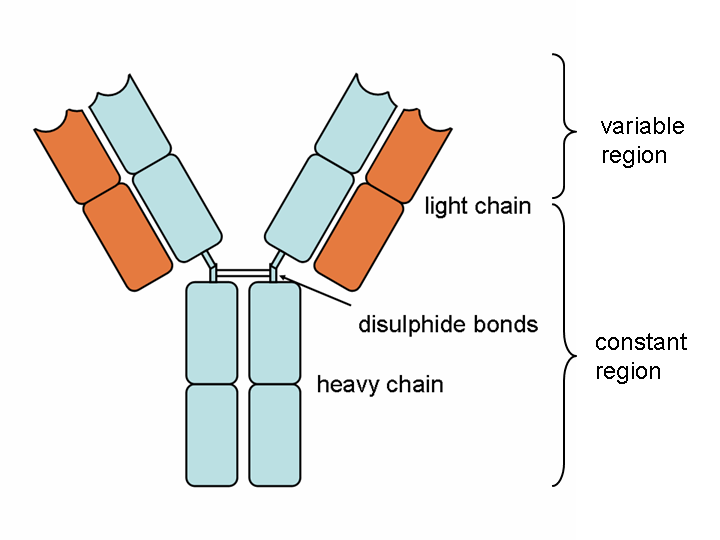
Pathology
Immune Responses
Which of the following immunoglobulin molecules can cross the placenta:
Answer:
Placental transfer of maternal IgG antibodies to the foetus is an important mechanism that provides protection to the infant while his/her humoral response is inefficient. IgG is the only antibody class that significantly crosses the human placenta.Immunoglobulins
Pathology / Immune Responses
Last Updated: 26th June 2019
Immunoglobulin molecules are composed of two identical heavy and two identical light chains linked by disulphide bridges. The heavy and light chains each have highly variable regions, which give the immunoglobulin specificity, and constant regions, in which there is virtual complete correspondence in amino acid sequence in all antibodies of a given isotype.

(Immunoglobulin Structure. (Image by User Je at uwo on en.wikipedia [Public domain])
Types
There are five isotypes of immunoglobulin: IgG, IgA, IgM, IgE and IgD, which are determined by the heavy chain (gamma, alpha, mu, epsilon or delta respectively); the light chains are either kappa or lambda.
- IgG is the most abundant in plasma (comprising 80% of normal serum immunoglobulin) and the main circulatory Ig for the secondary immune response; it is the only Ig that can cross the placenta.
- IgM is the main Ig in the primary immune response and the most proficient at complement fixation.
- IgA is the major Ig in secretions, particularly from the gastrointestinal tract (but also in saliva, tears, sweat and breast milk).
- IgE is important for mast cell degranulation in allergic and antiparasitic response.
- IgD is expressed on naive B-cells and its function is not known.
Function
Antibodies:
- Neutralise toxins and prevent attachment of pathogens
- Target, opsonise or agglutinate (clump together) antigens for phagocytosis
- Activate the complement cascade (leading to lysis or opsonisation of the pathogen)
- Act as antigen receptors on B lymphocytes
- Activate antibody-dependent cell-mediated cytotoxicity by natural killer (NK) cells or T cytotoxic cells
- Provide mucosal immunity (IgA-mediated)
- Stimulate degranulation of mast cells (IgE and IgG mediated)
- Provide passive immunity to the newborn (through transplacental passage of IgG and secretion of IgA in breast milk)
Report A Problem
Is there something wrong with this question? Let us know and we’ll fix it as soon as possible.
Loading Form...
- Biochemistry
- Blood Gases
- Haematology
| Biochemistry | Normal Value |
|---|---|
| Sodium | 135 – 145 mmol/l |
| Potassium | 3.0 – 4.5 mmol/l |
| Urea | 2.5 – 7.5 mmol/l |
| Glucose | 3.5 – 5.0 mmol/l |
| Creatinine | 35 – 135 μmol/l |
| Alanine Aminotransferase (ALT) | 5 – 35 U/l |
| Gamma-glutamyl Transferase (GGT) | < 65 U/l |
| Alkaline Phosphatase (ALP) | 30 – 135 U/l |
| Aspartate Aminotransferase (AST) | < 40 U/l |
| Total Protein | 60 – 80 g/l |
| Albumin | 35 – 50 g/l |
| Globulin | 2.4 – 3.5 g/dl |
| Amylase | < 70 U/l |
| Total Bilirubin | 3 – 17 μmol/l |
| Calcium | 2.1 – 2.5 mmol/l |
| Chloride | 95 – 105 mmol/l |
| Phosphate | 0.8 – 1.4 mmol/l |
| Haematology | Normal Value |
|---|---|
| Haemoglobin | 11.5 – 16.6 g/dl |
| White Blood Cells | 4.0 – 11.0 x 109/l |
| Platelets | 150 – 450 x 109/l |
| MCV | 80 – 96 fl |
| MCHC | 32 – 36 g/dl |
| Neutrophils | 2.0 – 7.5 x 109/l |
| Lymphocytes | 1.5 – 4.0 x 109/l |
| Monocytes | 0.3 – 1.0 x 109/l |
| Eosinophils | 0.1 – 0.5 x 109/l |
| Basophils | < 0.2 x 109/l |
| Reticulocytes | < 2% |
| Haematocrit | 0.35 – 0.49 |
| Red Cell Distribution Width | 11 – 15% |
| Blood Gases | Normal Value |
|---|---|
| pH | 7.35 – 7.45 |
| pO2 | 11 – 14 kPa |
| pCO2 | 4.5 – 6.0 kPa |
| Base Excess | -2 – +2 mmol/l |
| Bicarbonate | 24 – 30 mmol/l |
| Lactate | < 2 mmol/l |

